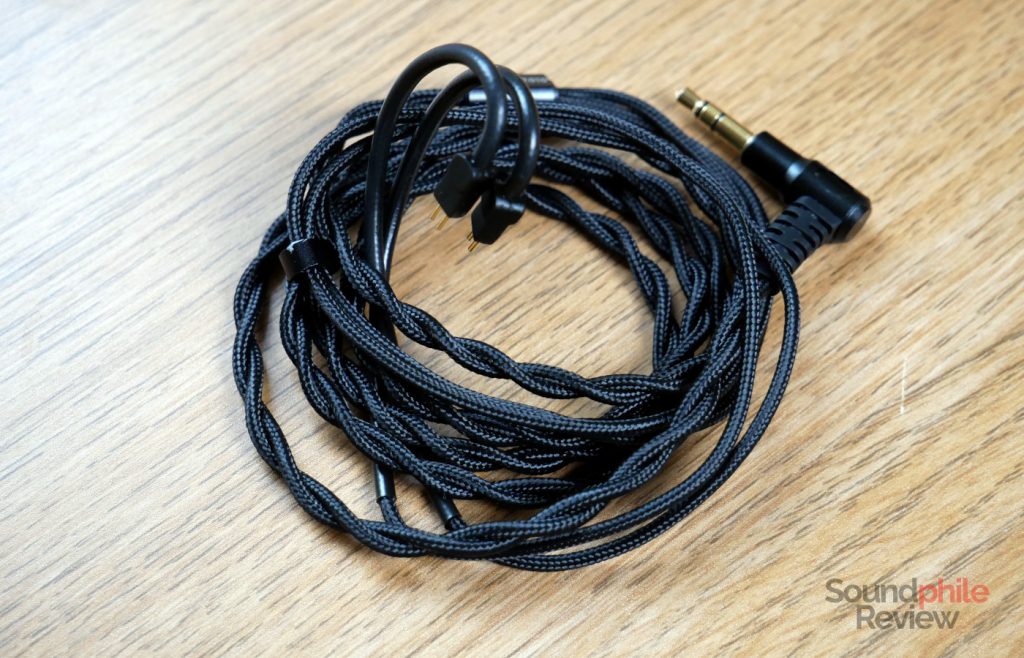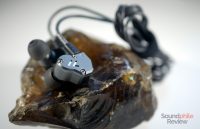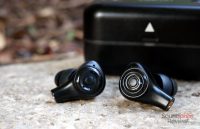Moondrop has created quite successful earphones in the past and it seems bent on making its designs cheaper and cheaper. The new Moondrop Aria is basically a KXXS at half the price, which is quite remarkable in and of itself. At just a hair less than $100, the Aria are an incredibly good option for the price if you want earphones with a Harman-like tuning.
Disclaimer: I received this unit from Shenzhen Audio free of charge. They sell the Aria for $79.99.
Buy from Shenzen Audio for $79.99
TL;DR: recap
| Pros |
Cons |
| + Very well built
+ Follows the Harman curve + Exceptional speed and detail + Very good technical ability |
– Low isolation
– Treble area could be a bit more refined |
Rating: 9.5/10
Packaging & Accessories
Moondrop always makes its packaging special in more than one way. The company is famous or putting anime-like characters on their packaging and the Aria make no exception. The contents of the box include the earphones with their removable cable, a hard carrying case and a set of 6 different sizes of eartips.
Design & Comfort

When I said that the Aria are a cheaper KXXS, I also meant that they have the same shells: triangular with very soft curves that help with comfort. The difference is just in the faceplates, which are flat instead of being multifaceted. The other major difference is the paint job: while the KXXS are shiny metal, the Aria are painted matte black with silvery-golden lines (the colour seems to change with the light). The Aria might actually be more elegant!

Build quality is quite high and very much in line with expectations (if not above!) for earphones in this price range. There is a visible seam between the shell and the faceplate, but it doesn’t detract from the overall looks or from the feeling of solidity given by the metal.

Comfort is exceptionally good, thanks to both the small size of the shells and the presence of the aforementioned curves that make the earphones fit in my ears effortlessly. They don’t apply pressure on any part of the pinna, so they should provide comfort even to those who have smaller ears (though, as always, comfort is deeply personal and your experience may be different from mine).

Isolation is lacking, despite the full metal shell. The Moondrop Aria just aren’t great from the perspective of excluding sounds coming from outside.

The cable is made of two cores individually sleeved with nylon fabric. Each core is made of silver-plated copper. They’re twisted between the right-angled 3.5 mm jack and the Y-split (which also has a chin slider), but then they split and there’s a single core per channel. There’s very little microphonics and the softness is there as well.
Sound & Specs
I spent most of the time listening to the Moondrop Aria using a Topping DX7 and a Drop THX AAA 789. Music files were mostly FLACs in CD quality.
Moondrop Aria |
| Frequency response | 5 – 36,000 Hz |
| Impedance | N/A |
| Sensitivity | 122 dB |
Like the other Moondrop earphones, the Aria target the Harman curve. This makes them sound neutral to most people as it is in fact a great compromise between the various components of the sound. The Aria use a 10 mm dynamic driver using the “liquid crystal polymer diaphragm” technology. Its low impedance and very high sensitivity mean that any source is virtually able to drive them to their fullest potential, including most smartphones and laptops.
Soundstage has good lateral extension but little depth and doesn’t often manage to defeat the sensation that music comes from inside your ears, even though sometimes it surprisingly does quite well. Imaging has good accuracy in placing instruments in their own place, but tends to do so in the three main areas (left, centre, right) with little left to the areas in between them. Instrument separation is quite good, though in the most complex tracks it’s not always easy to tell each individual part apart from the rest.
Bass can be seen as mostly neutral: it is mostly concentrated in the mid-bass section, leaving sub-bass a bit behind and without the same presence and energy. Still, extension is quite great for headphones in this price range, though you have to raise the volume quite a bit to hear the lowest notes with enough clarity. Bass is neither super-fast or hyper-detailed, but it does offer very reasonable speed and a great amount of detail that rivals earphones with double the price. The texture of bass in Massive Attack’s Angel is just out of this world for a sub-$100 earphone and is nothing less than stunning. Layering is also quite great.
Midrange has quite good tonality, with the additional touch of presence in the upper area that is typical of the Harman curve. It sounds quite balanced overall, with a good body that counterbalances the upper emphasis. This means that most instruments, from pianos and male vocals to trumpets and violins, have a correct tonal representation and have the same space in the mix. There’s a great amount of detail and there’s quite good speed as well, so transients are convincingly fast.
I find treble on the Aria impressive. It is airy and open, with a lot of sparkle that is quite pleasant and which offers a good counterbalance to bass. Extension is quite good as well, though there’s a cliff in the upmost area. Before that there are a couple of peaks and dips which can make music a bit fatiguing on the long run if it’s especially rich of cymbals; conversely, the dips are felt in that it sounds as if some pieces are missing. Overall it’s still quite a well-tuned treble region. The level of detail is impressive for the price, even more so as it is heard effortlessly.
Moondrop Aria Comparisons
At less than $100, the Aria have a lot of competition. Let’s see how they stack against them:
- Moondrop Aria vs Moondrop KXXS: the extraordinary thing about the Aria is that they are basically a copy of the KXXS. The tuning is almost identical, with the Aria having less bass extension and more presence in the mid-bass area, together with slightly warmer mids and slightly less extended treble. The differences are very small though, so much so that I had to compare them multiple times to locate them. They do sound a bit more lively and entertaining, which can be seen as good for many people, as well as a higher level of detail, but speed is better on the KXXS. The Aria have a slightly larger soundstage, similar imaging and better instrument separation. Considering they cost less than half the launch price of the KXXS, they’re a small miracle!
- Moondrop Aria vs Shanling ME80: the Shanling ME80 are quite different in their approach. They offer less extended bass which is also less present in the mix, leading them to be less warm overall. This diminished warmth is reinforced by the upper mids being more emphasised. Treble is more emphasised in the middle region, sounding more extended as a consequence; it also sounds more present in the mix. The level of detail is overall comparable, even though the Aria have a slightly advantage over the ME80. Soundstage is wider on the ME80, while imaging is comparable and instrument separation is better on the Aria.
- Moondrop Aria vs Tin HiFi T4: the T4, while great, are not on the same level as the Aria. Their bass is not as extended, with less speed as well. Midrange has more emphasis on the upper region, though it’s not large, and again it’s not as fast. Treble is less extended and the lower area is more emphasised as well. The most glaring difference, though, is detail: the T4 sound almost lacking in detail compared to the Aria. Instrument separation is the other area where the Aria prevail hands down over the T4. Soundstage is a bit wider on the T4, while imaging is comparable. It’s quite incredible that Moondrop managed to create earphones that undercut the T4 while being better all around!
Final Thoughts
The Moondrop Aria are impressive budget earphones. At just $80 they are extremely competent and deliver a great mix of technicalities and tonality. They have just a couple of flaws, which is the added emphasis on upper midrange and the peaks and dips in the treble area, but they are quite minor in the grander scheme. Everything else they execute with incredible ability and that’s quite amazing given how little they retail for.
The value offering of the Aria is through the roof. I’m not one to hype earphones, but these are indeed great and one astounding reminder that price does not always perfectly correlate with price. They’re not “giant slayers”, but surely the Moondrop Aria show how good affordable earphones can be nowadays – while they don’t compete with modern high-end models, they are in many ways comparable to high-end models from just 3 or 4 years ago. They deserve my full recommendation as an extremely solid offering.












Is UA@ a good option for aria?
I’m pretty underwhelmed with mine. They have neither strong bass slam or good detail retrieval and they aren’t sensitive enough to be driven to desired levels on a Pixel 3A. I’m very much not an IEM guy, so people gushing about how great these are tends to reinforce my belief that IEMs can’t really hold a candle to proper headphones.
They aren’t offensive, but there isn’t anything about them that wowed me or put a smile on my face so far
Hey Bull,
Well, it’s not really about IEMs not holding a candle to full-size expectations, but about how headphones are tuned. The Aria are not meant to give you strong bass slam, they’re meant to be neutral. Detail retrieval is quite good for the price range and absolutely comparable to, if not better than, full-size headphones of the same price.
As for the sensitivity, these are extremely sensitive at 122 dB/mW and I have to use an attenuator on my Honor 9 phone, so I wonder whether your Pixel 3A has too low an output (though that would be quite weird, given how people report driving Sennheiser HD579 without a problem with it) or if you just listen to music at incredibly high volume.
In the end, I think it’s all just down to expectations.
Love mine. I’m coming from 1060C, MSR7B, and Anandas. Yes the stage isn’t huge but the detail is still up there. Bass is pretty good with FA type E tips. I’m impressed for $80. Great size. They’re not flashy. And I didn’t want to spend Ananda tendies on IEMs that are easier to lose. Their bass sounds fuller than my Anandas too but lack the sound stage of the Anandas which I’m 100% ok with given their closed setup and $80 price tag, I can live with that. They still fetch the details and bass well for me.
My go to headphones for bass that I own are M1060C
For detail and sound stage Anandas ftw
And I use the MSR7B for gaming and travel
I use the Aria’s DAILY at work for breaks with my DX300 DAP
I picked those up recently and I have to say, they are really solid. I also own a pair of Hifiman XS’s but I find the aria’s are more enjoyable to listen to (while the Hifiman’s are technically better I guess). Those are a steal for sure.